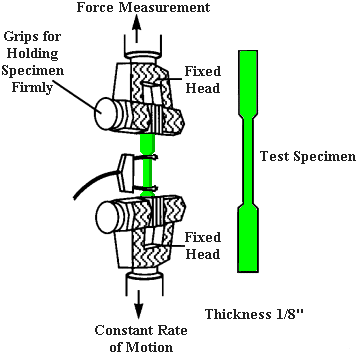
Tensile Property Testing of Plastics
Ultimate Tensile Strength
The ability to resist breaking under tensile stress is one of the most important and widely measured properties of materials used in structural applications. The force per unit area (MPa or psi) required to break a material in such a manner is the ultimate tensile strength or tensile strength at break . The rate at which a sample is pulled apart in the test can range from 0.2 to 20 inches per minute and will influence the results. The analogous test to measure tensile properties in the ISO system is ISO 527. The values reported in the ASTM D638 and ISO 527 tests in general do not vary significantly and either test will provide good results early in the material selection process. Separate tensile test methods are commonly applied to polymer films (ASTM D882 or ISO 1184) and elastomers (ASTM D412 or ISO 37).
The figure below, from Mitsubishi Chemical Advanced Materials, shows the test geometry.
 ASTM D638:For this test, plastic samples are either machined from stock shapes or injection molded. The tensile testing machine pulls the sample from both ends and measures the force required to pull the specimen apart and how much the sample stretches before breaking.
ASTM D638:For this test, plastic samples are either machined from stock shapes or injection molded. The tensile testing machine pulls the sample from both ends and measures the force required to pull the specimen apart and how much the sample stretches before breaking.
Tensile Elongation
The ultimate elongation of an engineering material is the percentage increase in length that occurs before it breaks under tension. Ultimate elongation values of several hundred percent are common for elastomers and film/packaging polyolefins. Rigid plastics, especially fiber reinforced ones, often exhibit values under 5%. The combination of high ultimate tensile strength and high elongation leads to materials of high toughness.
Tensile Modulus of Elasticity
The tensile modulus is the ratio of stress to elastic strain in tension. A high tensile modulus means that the material is rigid - more stress is required to produce a given amnount of strain. In polymers, the tensile modulus and compressive modulus can be close or may vary widely. This variation may be 50% or more, depending on resin type, reinforcing agents, and processing methods. The tensile and compressive moduli are often very close for metals.
The table below lists average ultimate tensile strength, elongation at break, and tensile moduli values for some filled and unfilled polymers.
Typical Tensile Strength, Elongation, and Tensile Modulus of Polymers
